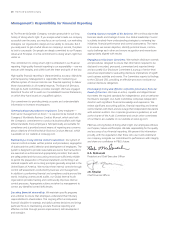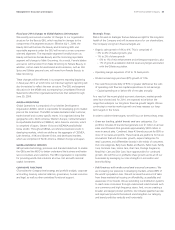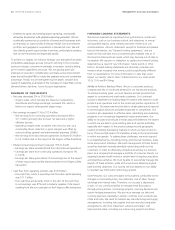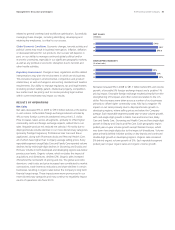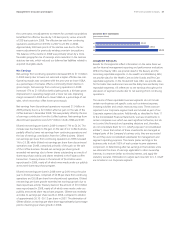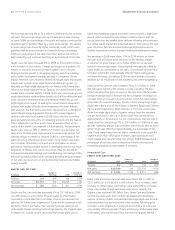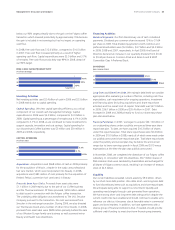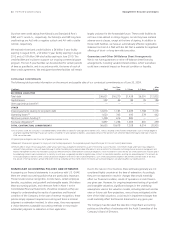Proctor and Gamble 2009 Annual Report Download - page 36
Download and view the complete annual report
Please find page 36 of the 2009 Proctor and Gamble annual report below. You can navigate through the pages in the report by either clicking on the pages listed below, or by using the keyword search tool below to find specific information within the annual report.34 The Procter & Gamble Company Management’s Discussion and Analysis
ō Continue to grow and develop faster-growing, structurally
attractive businesses with global leadership potential. We are
continually optimizing our portfolio of brands and businesses with
an emphasis on opportunities in Beauty, Health Care and selective
portfolio and geographic acquisitions in Household Care. We will
also identify growth opportunities in services, particularly businesses
that can be franchised and expanded rapidly.
To achieve our targets, we will also leverage core strengths that create
competitive advantages and are critical to winning in the consumer
products industry: consumer knowledge, innovation, brand-building,
go-to-market capabilities and scale. We are placing particular
emphasis on execution, simplification and scale as key improvement
areas that will enable P&G to create the greatest value and competitive
advantage. Finally, we are strengthening the depth, breadth and
quality of leadership at all levels of the Company to make P&G a more
demand-driven, real-time, future-focused organization.
SUMMARY OF 2009 RESULTS
ō Net sales decreased 3% to $79.0billion.
– Organic sales, which exclude the impacts of acquisitions,
divestitures and foreign exchange, increased 2%, which is
below our organic sales growth target range.
ō Net earnings increased 11% to $13.4billion.
– Net earnings from continuing operations decreased 4% to
$11.3billion primarily due to lower net sales and a higher
effective tax rate.
– Operating margins were consistent with the prior year, as a
commodity-driven reduction in gross margins was offset by
reduced selling, general and administrative expenses (SG&A).
–Net earnings from discontinued operations increased $1.9billion
to $2.1billion due to the impact of the Folgers coffee divestiture.
ō Diluted net earnings per share increased 17% to $4.26.
–Earnings per share included $0.68 from discontinued operations.
–Earnings per share from continuing operations increased 1%
to $3.58.
–Earnings per share grew ahead of net earnings due to the impact
of share repurchases and the shares tendered in the Folgers coffee
transaction.
ō Cash flow from operating activities was $14.9billion.
– Free cash flow, which is operating cash flow less capital spending,
was $11.7billion.
–Free cash flow productivity, which is the ratio of free cash flow
to net earnings, was 87% and included a negative 15% impact
resulting from the non-cash gain on the Folgers coffee transaction.
FORWARD-LOOKING STATEMENTS
We discuss expectations regarding future performance, events and
outcomes, such as our business outlook and objectives, in annual
and quarterly reports, press releases and other written and oral
communications. All such statements, except for historical and present
factual information, are “forward-looking statements,” and are
based on financial data and our business plans available only as of
the time the statements are made, which may become out-of-date or
incomplete. We assume no obligation to update any forward-looking
statements as a result of new information, future events or other
factors. Forward-looking statements are inherently uncertain and
investors must recognize that events could be significantly different
from our expectations. For more information on risks that could
impact our results, refer to Item 1A Risk Factors in our most recent
10-Q, 10-K and 8-K filings.
Ability to Achieve Business Plans.We are a consumer products
company and rely on continued demand for our brands and products.
To achieve business goals, we must develop and sell products that
appeal to consumers and retail trade customers. Our continued
success is dependent on leading-edge innovation with respect to both
products and operations and on the continued positive reputations of
our brands. This means we must be able to obtain patents and respond
to technological advances and patents granted to competition. Our
success is also dependent on effective sales, advertising and marketing
programs in an increasingly fragmented media environment. Our
ability to innovate and execute in these areas will determine the extent
to which we are able to grow existing sales and volume profitably,
especially with respect to the product categories and geographic
markets (including developing markets) in which we have chosen to
focus. There are high levels of competitive activity in the environments
in which we operate. To address these challenges, we must respond
to competitive factors, including pricing, promotional incentives, trade
terms and product initiatives. We must manage each of these factors,
as well as maintain mutually beneficial relationships with our key
customers, in order to effectively compete and achieve our business
plans. As a company that manages a portfolio of consumer brands, our
ongoing business model involves a certain level of ongoing acquisition
and divestiture activities. We must be able to successfully manage the
impacts of these activities, while at the same time delivering against
base business objectives. Our success will also depend on our ability
to maintain key information technology systems.
Cost Pressures. Our costs are subject to fluctuations, particularly due to
changes in commodity prices, raw materials, cost of labor, foreign
exchange and interest rates. Therefore, our success is dependent,
in part, on our continued ability to manage these fluctuations
through pricing actions, cost savings projects, sourcing decisions and
certain hedging transactions. We also must manage our debt and
currency exposure, especially in certain countries, such as Venezuela,
China and India. We need to maintain key manufacturing and supply
arrangements, including sole supplier and sole manufacturing plant
arrangements. We must implement, achieve and sustain cost
improvement plans, including our outsourcing projects and those






